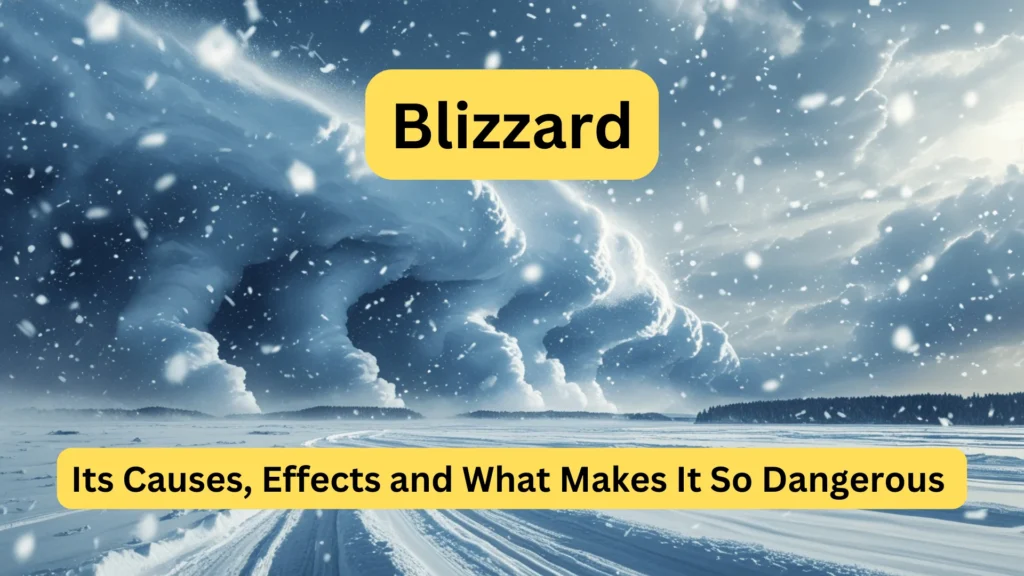
Introduction
Definition of a Blizzard
A blizzard is a severe snowstorm characterized by strong sustained winds, low visibility, and heavy snowfall. The National Weather Service (NWS) in the United States defines a blizzard as a storm with sustained winds or frequent gusts of 35 miles per hour (56 kilometers per hour) or more, accompanied by falling or blowing snow that reduces visibility to less than a quarter of a mile (about 400 meters) for at least three hours. Unlike a typical snowstorm, a blizzard’s defining features are its wind speed and the reduction in visibility, rather than the amount of snowfall. This distinction is crucial because even moderate snowfall can become perilous under blizzard conditions due to the strong winds and reduced visibility.
Brief Overview of Why Blizzards are Significant
They are significant for several reasons, impacting both human life and the environment. Their ability to rapidly reduce visibility and create life-threatening conditions makes them a critical concern for meteorologists, emergency services, and the public. Blizzards can lead to transportation paralysis, with roads, railways, and airports often shutting down during severe events. This disruption can impede the delivery of essential services, leading to economic losses and logistical challenges in affected regions.
Additionally, the extreme cold and wind chill associated with blizzards pose severe risks to human health, including hypothermia and frostbite. These conditions can be fatal, particularly for vulnerable populations such as the elderly, the homeless, and those with pre-existing health conditions. Beyond the immediate human impact, blizzards can also cause significant damage to infrastructure, including power lines and buildings, often resulting in prolonged power outages and costly repairs.
Ecologically, blizzards can have both short-term and long-term effects on the environment. In the short term, heavy snow accumulation can impact local flora and fauna, while in the long term, the melting snow contributes to water supplies and can influence local hydrology. Understanding the dynamics and potential impacts of blizzards is essential for preparing and mitigating their effects, making them a topic of significant importance for public safety and environmental management.
By recognizing the characteristics and impacts of blizzards, communities can better prepare for these severe weather events, minimizing their potentially devastating effects on life and property.
What Causes a Blizzard?
Meteorological Conditions Required for a Blizzard
Blizzards are complex weather events that require a specific combination of meteorological conditions. Understanding these conditions is essential for predicting and preparing for blizzards.
Temperature
Temperature plays a critical role in the formation of a blizzard. For a blizzard to occur, temperatures need to be low enough for snow to form and remain frozen. Typically, this means surface temperatures must be at or below freezing (32°F or 0°C). However, blizzards can form even when surface temperatures are slightly above freezing if the air higher in the atmosphere is cold enough to create snow that reaches the ground before melting.
Temperature gradients also influence blizzard formation. A sharp contrast between cold polar air and relatively warmer air masses can create a dynamic environment conducive to the development of strong winter storms, which can escalate into blizzards.
Wind Speed
Strong winds are a defining characteristic of a blizzard. According to the National Weather Service, sustained winds or frequent gusts of at least 35 miles per hour (56 kilometers per hour) are necessary to classify a storm as a blizzard. These high wind speeds cause snow to blow and drift, reducing visibility and creating hazardous conditions.
The wind speed not only reduces visibility but also exacerbates the effects of cold temperatures through wind chill. This can make the perceived temperature significantly lower, increasing the risk of hypothermia and frostbite for anyone exposed to the elements.
Snowfall Rate
While the amount of snowfall is not the primary criterion for a blizzard, the rate at which snow falls can contribute to the severity of the storm. Heavy snowfall rates can quickly accumulate, compounding the effects of strong winds and low visibility. Snowfall rates during blizzards can vary, but it is not uncommon for snow to fall at a rate of 1 to 2 inches (2.5 to 5 centimeters) per hour during the peak of the storm.
Blizzards can also occur with relatively light snowfall if the wind speeds are high enough to cause blowing and drifting snow, creating whiteout conditions. In some cases, snow already on the ground can be lifted by the wind, leading to a “ground blizzard” where new snowfall is minimal, but visibility is still severely reduced.
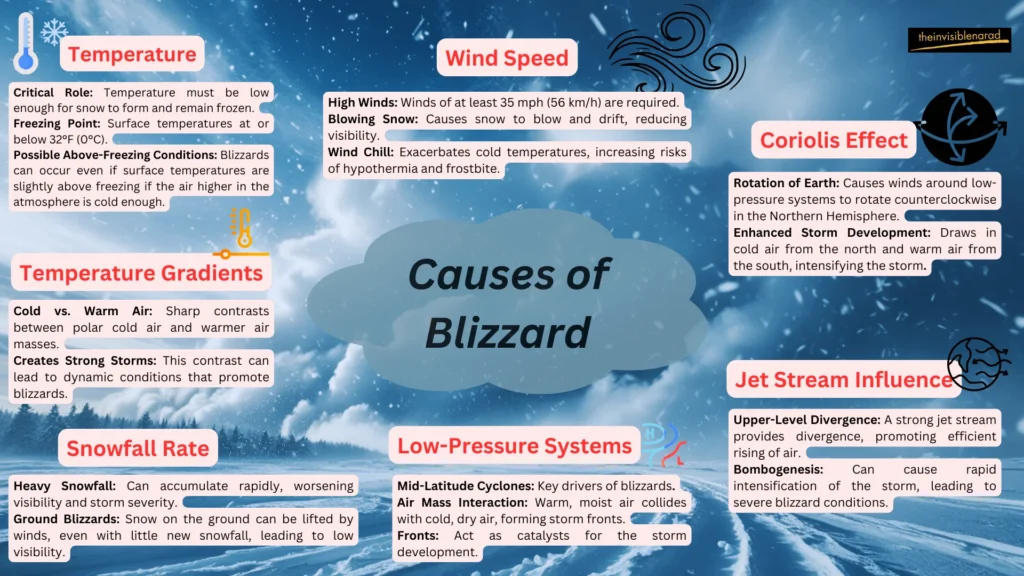
Atmospheric Dynamics Leading to Blizzard Formation
Blizzard formation involves complex atmospheric dynamics, driven by interactions between different air masses and pressure systems.
A key factor in the development of blizzards is the presence of a strong low-pressure system, commonly referred to as a mid-latitude cyclone. These systems form when warm, moist air from lower latitudes collides with cold, dry air from the poles. The boundary between these air masses, known as a front, often acts as the catalyst for the development of intense storms.
As the low-pressure system intensifies, it creates a powerful uplift of warm air, which cools and condenses, leading to cloud formation and precipitation. The rotation of the Earth, known as the Coriolis effect, causes the air around the low-pressure system to circulate counterclockwise in the Northern Hemisphere. This circulation pattern helps draw in more cold air from the north and more warm air from the south, further intensifying the storm.
Upper-level atmospheric conditions also play a crucial role. A strong jet stream can enhance the development of a low-pressure system by providing upper-level divergence, which allows the air at the surface to rise more efficiently. This process can lead to rapid intensification of the storm, often referred to as “bombogenesis” or a “bomb cyclone,” which can result in severe blizzard conditions.
Blizzards are the result of a delicate interplay between temperature, wind speed, snowfall rate, and atmospheric dynamics. Understanding these factors is vital for meteorologists to predict blizzards accurately and issue timely warnings to mitigate their impact on communities and infrastructure.
Characteristics of a Blizzard
Blizzards are distinguished by a combination of severe weather conditions that make them dangerous and disruptive. Understanding these characteristics helps in accurately identifying blizzards and preparing for their impact.
Wind Speeds and Visibility
Wind speed is a fundamental characteristic of a blizzard, often the most dangerous aspect. To qualify as a blizzard, sustained winds or frequent gusts must reach at least 35 miles per hour (56 kilometers per hour). These high wind speeds cause blowing and drifting snow, which severely reduces visibility.
Visibility during a blizzard typically drops to less than a quarter of a mile (about 400 meters) and can sometimes decrease to near zero in severe cases, resulting in what is known as whiteout conditions. In a whiteout, it becomes nearly impossible to distinguish between the ground and the sky, making navigation extremely dangerous and disorienting. These conditions can lead to transportation accidents and hinder emergency response efforts.
The combination of strong winds and blowing snow can also lead to significant snow drifts, burying roads, vehicles, and buildings under several feet of snow, further compounding the challenges posed by the blizzard.
Temperature Extremes
Blizzards often bring extreme cold, with temperatures dropping well below freezing. The wind chill factor, which measures the perceived decrease in temperature felt by the skin due to the wind, can make the cold feel even more severe. Wind chill values during blizzards can plunge to dangerously low levels, increasing the risk of hypothermia and frostbite for those exposed to the elements.
These temperature extremes can pose significant health risks, particularly for vulnerable populations such as the elderly, children, and individuals without adequate shelter. The cold can also strain infrastructure, leading to frozen pipes, power outages, and heating system failures.
Additionally, the cold temperatures associated with blizzards can persist for several days, prolonging the period of discomfort and danger for affected populations.
Duration and Intensity
The duration of a blizzard can vary, but for a storm to be classified as a blizzard, the severe conditions must last for at least three hours. However, some blizzards can persist much longer, lasting up to several days, which can magnify their impact.
The intensity of a blizzard depends on the strength of the associated low-pressure system and the dynamics of the air masses involved. Some blizzards develop rapidly and intensify quickly, while others may gradually build over time. The most intense blizzards, often called “nor’easters” in the northeastern United States, can cause widespread disruption, with heavy snowfall, hurricane-force winds, and coastal flooding in addition to the typical characteristics of a blizzard.
The combination of high wind speeds, heavy snowfall, and low temperatures over an extended period creates a severe weather event that can overwhelm infrastructure and emergency services, leading to widespread disruption and requiring significant recovery efforts.
The characteristics of a blizzard—strong winds, reduced visibility, extreme cold, and prolonged duration—make it a formidable natural phenomenon. Understanding these traits is essential for accurate forecasting, effective response, and preparation to mitigate the impact on communities and individuals.
Types of Blizzards
While generally defined by their intense winds, low visibility, and heavy snowfall, can manifest in various forms depending on specific atmospheric conditions and geographical factors. Understanding these types can help in better preparation and response to these severe weather events.
Ground Blizzards
Ground blizzards are unique in that they occur with little to no new snowfall. Instead, strong winds lift and blow already fallen snow, creating blizzard-like conditions. These blizzards typically develop after a significant snowstorm, especially in flat, open areas such as plains and prairies where there are few natural barriers to block the wind.
The wind-driven snow reduces visibility drastically, creating whiteout conditions similar to those of a traditional blizzard. Ground blizzards can be just as dangerous as blizzards accompanied by new snowfall, as they can cause significant drifts, obstruct roadways, and pose serious risks to transportation and outdoor activities. These blizzards often catch people off guard because they can develop suddenly and without the usual warning signs of incoming heavy snow.
Snowstorms Turning into Blizzards
Many blizzards begin as regular snowstorms but intensify as specific meteorological conditions converge. For a snowstorm to escalate into a blizzard, it must develop strong winds and drastically reduced visibility due to blowing or falling snow. This transformation can occur when a low-pressure system deepens rapidly, a process often referred to as bombogenesis or the development of a “bomb cyclone.”
The strengthening of the storm is usually driven by significant temperature contrasts between cold polar air and warmer air masses, along with a powerful jet stream at higher altitudes. This setup can enhance wind speeds and increase the intensity of snowfall, leading to its conditions. These types of blizzards can cover vast areas and are often accompanied by other severe weather phenomena, such as thunder and lightning, in what is sometimes called “thundersnow.”
Ice Storms and Their Relation to Blizzards
Although ice storms and blizzards are distinct types of winter weather events, they can be related under certain conditions. An ice storm is characterized by the accumulation of freezing rain, which coats surfaces in a layer of ice. Unlike it, ice storms do not involve strong winds or significant snowfall. However, an ice storm can precede or follow a blizzard, complicating the situation.
When an ice storm occurs before a blizzard, it can create a dangerous base layer of ice under the snow, making roads and sidewalks treacherous. If high winds from a blizzard follow an ice storm, they can cause ice-laden trees and power lines to break, leading to widespread power outages and damage. Conversely, a blizzard followed by an ice storm can result in a thick, heavy layer of snow topped with ice, posing structural risks to buildings and making snow removal efforts much more difficult.
While ice storms are typically more localized and involve less wind than blizzards, their combination can amplify the dangers associated with winter storms, leading to severe impacts on infrastructure, transportation, and human safety.
It can take various forms, from ground blizzards driven by strong winds and pre-existing snow to snowstorms that intensify into blizzards and the interaction of blizzards with ice storms. Each type presents unique challenges and hazards, emphasizing the importance of understanding the specific nature of each to prepare effectively and mitigate risks.
Historical Blizzard Events
They are powerful natural events that have had lasting impacts on societies, economies, and infrastructure throughout history. Some blizzards are so extreme that they become significant historical markers, shaping the development of communities and contributing to the evolution of weather forecasting, emergency response, and public safety measures. Examining notable blizzards offers valuable insights into their catastrophic effects and the resilience required to recover from them.
Notable Blizzards in History
The Great Blizzard of 1888
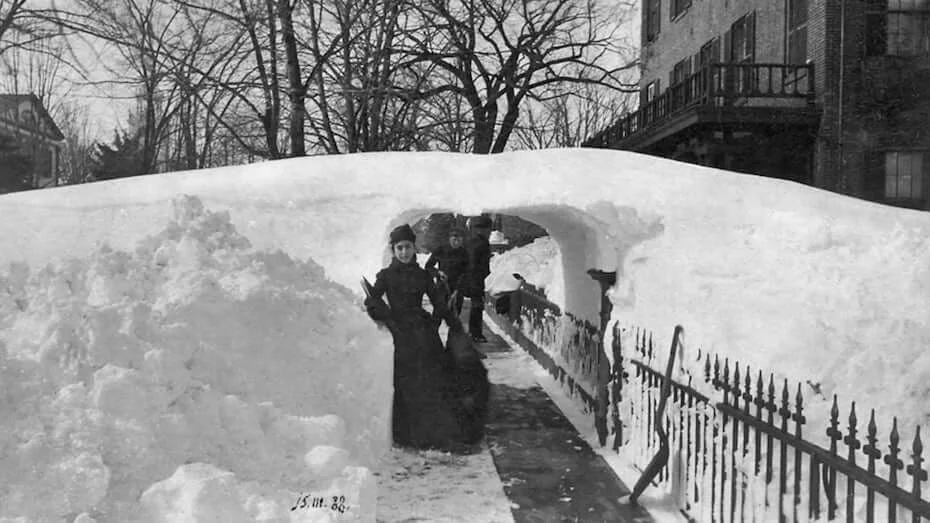
One of the most infamous blizzards in North American history, the Great Blizzard of 1888, struck the northeastern United States from March 11 to 14, 1888. Known as the “Blizzard of ’88,” this event was one of the deadliest and most destructive in the history of the United States. The storm was characterized by heavy snowfall, wind gusts up to 80 mph (130 km/h), and temperatures plummeting to as low as -10°F (-23°C).
The Great Blizzard of 1888 dumped as much as 50 inches (127 cm) of snow in some areas, particularly in New York and New Jersey. The wind created massive drifts that buried entire streets and railroad tracks. The blizzard’s ferocity and its effects on transportation caused widespread disruption. Communication between cities was completely cut off, and the storm killed over 400 people, many of them trapped in snowdrifts or stranded in freezing temperatures. The storm’s aftermath also brought long-lasting changes to infrastructure. As a result, cities began implementing more modern and efficient snow removal systems, and the creation of organized weather forecasting systems became a priority.
The 1972 Iran Blizzard
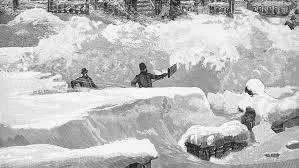
The 1972 Iran Blizzard, often cited as one of the most severe blizzards in modern history, occurred between February 3 and 9, 1972, and claimed thousands of lives. This catastrophic event struck northern Iran, with the heaviest snowfall recorded in the mountains and plains. The blizzard’s intensity was exacerbated by wind gusts of up to 70 mph (113 km/h) and extremely cold temperatures that fell to -20°F (-29°C).
Over 26 feet (8 meters) of snow accumulated in some areas, and entire villages were buried under drifts. The scale of the storm was so large that it paralyzed entire regions, trapping people in their homes and vehicles for days. It caused the deaths of over 4,000 people and displaced tens of thousands more. Rescue efforts were severely hampered due to the inaccessibility of many remote areas, and Iran’s transportation networks were almost entirely destroyed.
The storm also led to significant changes in how emergency response systems were structured in the region. The scale of destruction demonstrated the need for better disaster management infrastructure, and as a result, national and local authorities began investing in snow removal and disaster relief systems, especially in remote and mountainous areas.
The 1993 Storm of the Century
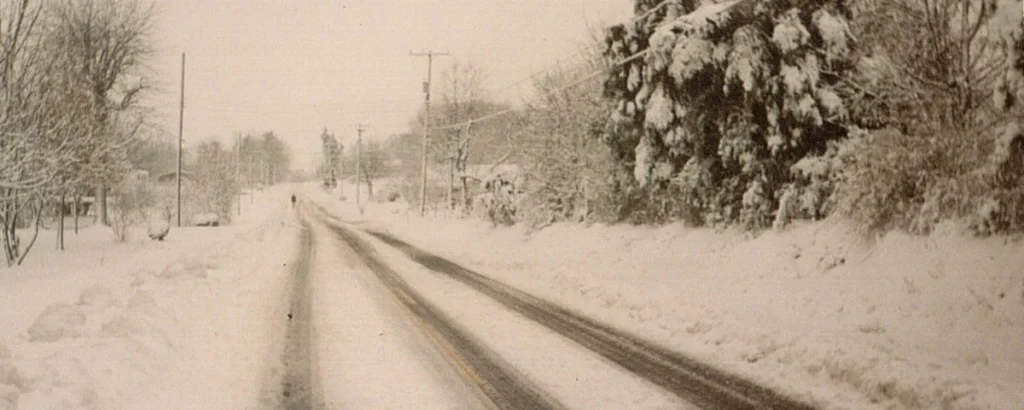
The 1993 Storm of the Century, which occurred from March 12 to 14, 1993, is often regarded as one of the most significant and widespread of it in U.S. history. It affected a large portion of the eastern United States, from the Gulf Coast up to Canada, and caused substantial damage in both urban and rural areas.
This massive storm brought blizzard conditions, freezing rain, and heavy snow, with some regions receiving up to 2 feet (61 cm) of snow. What made the Storm of the Century particularly remarkable was its rapid development and the scope of its impact. The storm was not only strong but also covered an area of about 1,000 miles, leaving millions of people without power and grounding thousands of flights. In addition to the snow, high winds and icy conditions resulted in widespread power outages and extensive tree damage.
The storm claimed over 300 lives and caused damages totaling billions of dollars. The severity and breadth of the storm led to significant improvements in weather forecasting and preparedness. Federal and state emergency response teams enhanced their capabilities for handling large-scale blizzards, and the event prompted a reevaluation of transportation safety protocols, leading to the introduction of better systems for monitoring and mitigating snow and ice hazards on roads.
Impact on Communities and Infrastructure
It is especially the historic events mentioned above, have a profound and lasting impact on both communities and infrastructure. These severe weather events often lead to widespread disruption of everyday life, with far-reaching consequences that affect not only the immediate aftermath but also long-term recovery efforts.
One of the most immediate impacts of it on communities is the disruption of transportation networks. Roads and highways become impassable, and rail and air travel are often brought to a halt. This can result in major delays for goods and services, as well as impede the movement of emergency responders. During the Great Blizzard of 1888, the shutdown of railroad systems caused a massive logistical challenge and delayed crucial supplies to affected regions. Similarly, the Storm of the Century in 1993 caused extensive flight cancellations, disrupting air travel for millions of passengers across the eastern U.S.
It also put a strain on infrastructure and emergency services. The heavy accumulation of snow and ice can cause power outages, as downed power lines and fallen trees disrupt electricity distribution. In 1972, during the Iran Blizzard, such power disruptions, combined with the difficulty in accessing rural areas, hampered rescue operations, leading to a higher death toll.
Moreover, it can cause significant damage to homes, buildings, and public infrastructure. Snow and ice accumulation on roofs can lead to collapses, and high winds can tear apart structures not designed to withstand such extreme conditions. This was notably seen in the 1993 Storm of the Century, where high winds combined with heavy snow caused severe roof damage and collapsed power lines across several states.
The long-term impact on communities can include economic losses due to business closures, agricultural damage, and the cost of rebuilding infrastructure. These events also prompt communities to reevaluate their preparedness for winter weather, leading to more robust systems for forecasting, response, and recovery. The legacy of these historical blizzards continues to shape policies and practices related to disaster preparedness, emphasizing the importance of infrastructure resilience, early warning systems, and efficient emergency management.
The historical blizzards highlighted above demonstrate the devastating impact such storms can have on communities and infrastructure. These events not only result in immediate loss of life and property but also prompt long-lasting changes in how societies prepare for and respond to severe winter weather, with lessons learned that continue to inform modern disaster management strategies.
Effects of Blizzards
They are extreme weather phenomena that bring more than just temporary inconveniences. Their effects can be devastating, both immediately and in the long term. While the intense cold, wind, and snow create hazardous conditions, the impact of blizzards extends far beyond the immediate storm itself. This section delves into the immediate dangers associated with blizzards, as well as their long-term consequences on the economy and the environment.
Immediate Dangers
They are dangerous events that present immediate and often life-threatening risks to anyone caught in them. These dangers stem from the combination of extreme cold, strong winds, and reduced visibility, all of which make survival challenging.
Hypothermia
Hypothermia is one of the most immediate and dangerous risks associated with blizzards. This condition occurs when the body’s core temperature drops below 95°F (35°C), leading to a slowing of bodily functions and potential organ failure. In a blizzard, the combination of freezing temperatures and high winds increases the rate at which body heat is lost, making hypothermia a very real threat for those exposed to the elements for too long.
The risk is particularly high for individuals who are stranded outdoors, whether due to car breakdowns, accidents, or getting lost. Without proper shelter, clothing, or means of generating heat, a person can succumb to hypothermia in a matter of hours. Early symptoms of hypothermia include shivering, confusion, and drowsiness, while more severe cases result in slurred speech, loss of coordination, and unconsciousness. To avoid death, medical attention must be given right away.
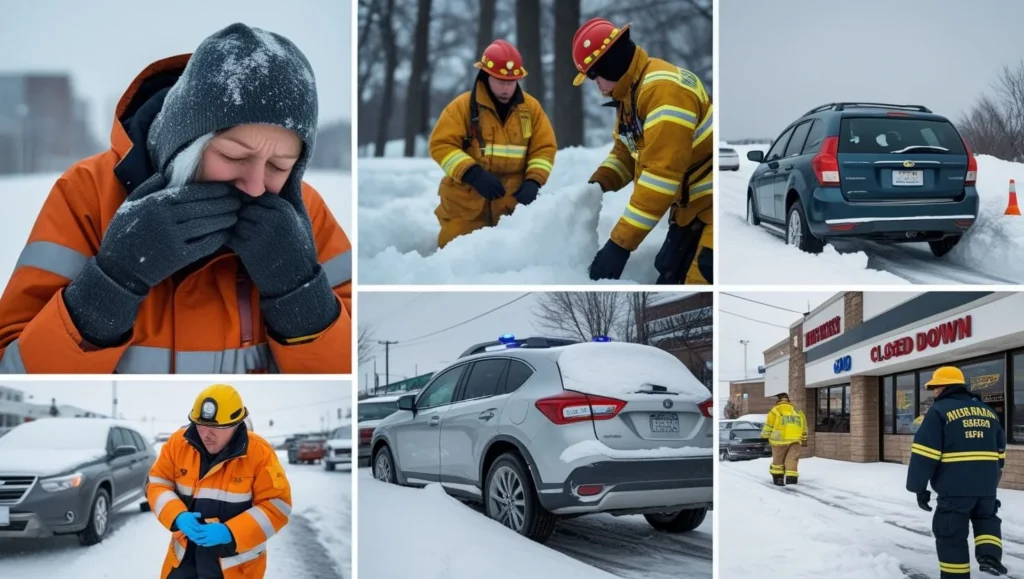
Frostbite
Another immediate danger during a blizzard is frostbite, a condition that occurs when skin and underlying tissues freeze due to prolonged exposure to freezing temperatures. Commonly affecting extremities like fingers, toes, ears, and the nose, frostbite can lead to permanent damage to the affected tissues and, in severe cases, amputation.
With their combination of low temperatures and wind chill, create ideal conditions for frostbite to develop rapidly. In the early stages, frostbite causes the skin to become pale, hard, and numb. If left untreated, the condition can progress, causing blisters and blackened, dead tissue. It is important for individuals caught in blizzard conditions to seek shelter and warmth as soon as possible, rewarming frozen areas slowly to avoid further injury.
Traffic Accidents
They are notorious for causing dangerous traffic conditions. Snow accumulation, ice on roads, and strong winds reduce visibility, making driving hazardous. In severe cases, roads become completely impassable, trapping vehicles and blocking rescue efforts. In places with heavy snow accumulation, roads may be snowed over, making it difficult to discern lanes or road signs, increasing the risk of accidents.
Accidents involving cars, trucks, and other vehicles can be deadly during it, not only due to the direct collision impact but also because the conditions hinder timely emergency responses. The severe winter conditions cause many people to lose control of their vehicles, leading to spinouts, collisions, and multi-vehicle pile-ups. In many instances, drivers are forced to abandon their vehicles in blizzard conditions, leading to additional risks of hypothermia and frostbite.
Long-Term Consequences
While the immediate effects of it can be catastrophic, the long-term consequences can also be profound. These effects extend into the economy, infrastructure, and even the environment, requiring substantial recovery efforts in the aftermath of it.
Economic Impact
The economic impact of it can be both wide-reaching and long-lasting. On an immediate level, it causes business closures, transportation disruptions, and delays in trade. Cities and regions hit hardest by blizzards often experience a slowdown in productivity as businesses, schools, and offices are forced to close, resulting in lost revenue.
The transportation sector is particularly vulnerable. Airlines often cancel flights during blizzards, which disrupts both passenger and freight travel. Similarly, road closures and restrictions prevent goods from reaching markets, leading to supply chain issues that can affect the availability and price of goods. The long-term recovery from a blizzard’s economic impact can take weeks or even months, especially in regions where heavy snow accumulation and damage to infrastructure require costly repair and restoration efforts.
In rural or agricultural areas, it can have a devastating effect on crops and livestock. If fields are covered in deep snow or if cold temperatures last too long, crops may be destroyed, and livestock may not survive the harsh conditions. This can lead to a loss of income for farmers and a rise in food prices, affecting broader economic stability.
Environmental Changes
It also have significant, though often less immediate, environmental consequences. When snow accumulates in large amounts, it can alter ecosystems and disrupt natural processes. For example, deep snow can prevent sunlight from reaching the ground, affecting plant life and potentially causing a delay in the growing season. In some cases, if snow persists for an extended period, it can cause certain species of plants to die off due to lack of sunlight and warmth.
It can also impact wildlife, especially for animals that rely on the availability of food or shelter in certain areas. The heavy snow cover can create barriers for some species, making it more difficult for them to find food or migrate. In areas where snow remains for months, animals may struggle to survive due to the lack of resources, particularly in regions that are already cold or barren.
The heavy winds and snowfall associated with it can also cause damage to forests and other natural landscapes. Trees and vegetation may be uprooted by the strong winds, while heavy snow can snap branches, leading to forest fragmentation. Additionally, the snowmelt that occurs after it can lead to soil erosion or flooding, particularly in mountainous regions where snow has accumulated in large amounts. These environmental changes can have ripple effects throughout the ecosystem, disrupting the delicate balance of plant and animal life.
Preparing for a Blizzard
They can strike unexpectedly, and being unprepared for their impact can have serious consequences. Preparation is key to minimizing the risks associated with these powerful storms. Whether you are at home, traveling, or in a community at risk of it, understanding how to prepare can save lives and reduce the damage caused by the storm. This section explores the steps that individuals and families can take to prepare for it.
Emergency Supplies and Kits
An essential part of preparing for it is ensuring that you have a well-stocked emergency kit. This kit should include a variety of items to ensure you can survive and stay safe in case you are stranded or lose power. Key supplies include:

- Non-perishable food: Stock up on canned goods, dry snacks, and ready-to-eat meals that do not require refrigeration. Aim to have enough supplies for at least three days per person.
- Water: Make sure to have at least one gallon of water per person per day for drinking and sanitation purposes.
- First aid supplies: A well-equipped first aid kit should include bandages, antiseptics, pain relievers, prescription medications, and any necessary medical devices.
- Flashlights and batteries: Because blizzards frequently cause power outages, having a dependable light source is essential. Stock up on extra batteries and consider solar-powered or hand-crank flashlights.
- Warm clothing and blankets: Ensure that you have plenty of warm clothing, including insulated coats, hats, gloves, and scarves. Additionally, store extra blankets, sleeping bags, or emergency thermal blankets to help maintain body heat in cold conditions.
- Portable power banks: These devices can charge your phone and other essential electronics if the power goes out.
- Shovel, ice scraper, and sand or salt: These tools can help you clear driveways, paths, and walkways, preventing accidents and ensuring safe movement.
- Battery-powered radio: Stay informed with weather updates by having a battery-powered or hand-crank radio that can tune into local emergency broadcasts.
Having these supplies on hand will ensure that you can weather the storm safely and effectively.
Home Preparation Tips
Home preparation is an integral part of safeguarding yourself and your family during it. When preparing your home, consider the following tips:
- Seal drafts and insulate windows: Strong winds and low temperatures can cause rapid heat loss from your home. Seal any drafts around windows and doors, and use heavy curtains or insulated window coverings to reduce heat loss. Consider applying weatherstripping around doors to keep cold air out.
- Check heating systems: Ensure that your heating system is functioning correctly. If you have a fireplace, wood stove, or other alternative heating source, make sure it is stocked with fuel and that the flue is clean and unobstructed.
- Install carbon monoxide detectors: If you use alternative heating sources such as generators, wood stoves, or kerosene heaters, install carbon monoxide detectors throughout your home to prevent poisoning. Make sure the detectors are fully operational and have fresh batteries.
- Maintain a supply of firewood: If you have a fireplace, stock up on firewood well in advance of the storm. Firewood will provide both heat and a source of comfort during extended power outages.
- Ensure accessibility: Keep pathways to and from your home clear of snow and ice. Ensure that you have a plan for getting to a shelter if necessary.
By making your home a secure and comfortable environment during a blizzard, you can reduce stress and stay focused on safety.
Travel Safety Precautions
Traveling during it is extremely dangerous and should be avoided unless absolutely necessary. However, if travel is essential, follow these precautions to protect yourself:
- Stay updated: Before traveling, check weather forecasts and road conditions. Be aware of blizzard warnings in your area, and postpone your trip if conditions are unfavorable.
- Keep your vehicle stocked: Keep an emergency kit in your car, including blankets, non-perishable food, water, a flashlight, and extra batteries. It’s also advisable to have a charged mobile phone with you.
- Ensure proper winter tires: Ensure your vehicle is equipped with winter tires, which offer better traction on icy and snowy roads. Keep your windshield wipers in good condition and fill your vehicle’s gas tank to prevent freezing in extreme cold.
- Avoid unnecessary travel: If it is forecasted, avoid traveling at all costs. Avoid driving during the storm and wait for the situation to improve if at all possible.
- Let someone know your plans: Always tell someone your intended route and expected arrival time in case of an emergency.
By following these precautions, you can minimize your risks and ensure your safety during a blizzard.
Responding to a Blizzard
Even with the best preparation, sometimes blizzards can still catch us by surprise. Knowing how to respond effectively during a blizzard is critical to staying safe. Immediate action and following safety protocols can make all the difference in minimizing injury and damage.
Guidelines for Staying Safe During a Blizzard
During it, safety is paramount. Here are some key guidelines for staying safe during the storm:
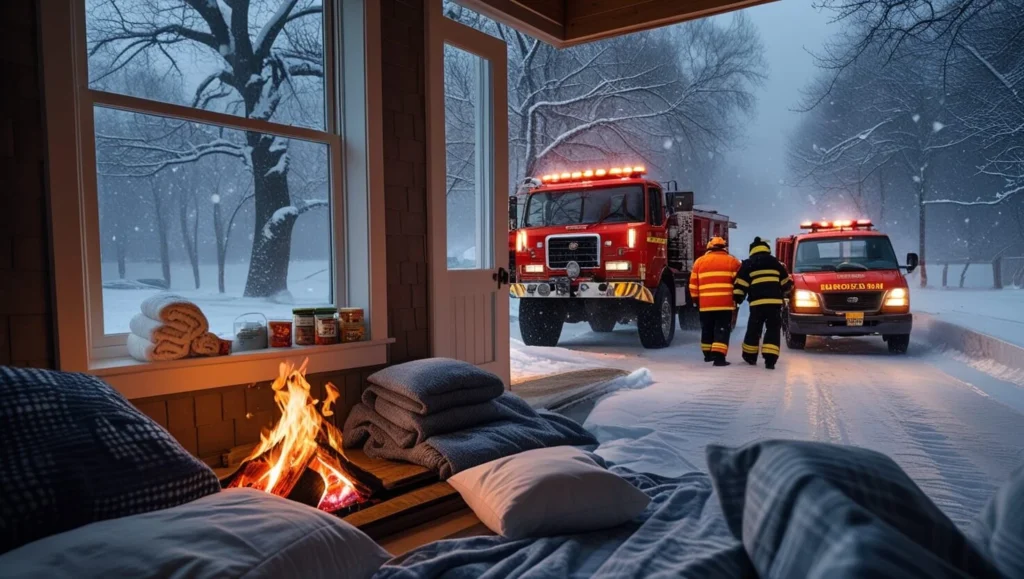
- Stay indoors: If possible, remain indoors throughout the duration of the blizzard. Avoid going outside, as exposure to extreme cold, high winds, and reduced visibility can be life-threatening.
- Limit activity: If you must go outside for any reason, take frequent breaks in a sheltered location to prevent exhaustion and exposure. To protect yourself, dress appropriately with caps, scarves, gloves, and insulated boots.
- Monitor weather updates: Pay attention to weather warnings and alerts. This will keep you updated on the storm’s progress and any new threats, such power outages or altered road conditions.
- Avoid using candles: In power outages, it is safer to use flashlights rather than candles to avoid the risk of fire. If you must use candles, ensure they are placed away from flammable materials and never leave them unattended.
- Stay away from windows: It can cause flying debris or structural damage to buildings. To prevent injuries from breaking glass, stay away from windows.
By following these guidelines, you can significantly reduce your risk during the storm.
Role of Emergency Services and Community Response
During it, emergency services and community responders play a critical role in ensuring the safety of affected individuals. These agencies may provide:
- Rescue operations: Emergency responders will assist stranded motorists and rescue people who may be in danger due to power outages or structural damage. If you are trapped, stay inside your vehicle or shelter until help arrives.
- Shelters: Community shelters may be set up to house those who are unable to remain in their homes due to unsafe conditions or power outages. Be aware of local shelter locations and seek refuge there if necessary.
- Medical assistance: In the case of hypothermia, frostbite, or other injuries, emergency medical teams will be ready to provide care. Contact the emergency services if you require medical assistance.
Conclusion
While awe-inspiring, are dangerous events that require proper preparation and knowledge of how to respond. The impact of it on your safety, health, and well-being can be minimized through careful planning, adequate supplies, and staying informed. Understanding blizzards and their potential effects is critical for individuals, families, and communities. By recognizing the dangers posed by extreme cold, wind, and snow, we can take proactive steps to protect ourselves and our loved ones. Preparedness is key to ensuring safety during these winter weather events, and the actions we take before, during, and after a blizzard can make all the difference.
In conclusion, here are a few final tips to ensure your safety during it prepare your emergency kit well in advance by making sure you have the necessary supplies to stay warm and nourished; stay informed by regularly checking weather forecasts and warnings; avoid unnecessary travel by staying off the roads if a blizzard is approaching; and follow safety guidelines by staying indoors during the storm and ensuring you have a reliable communication plan with others. By following these steps, you will be better equipped to handle it safely and minimize its impact on your life.
Frequently Asked Questions (FAQs)
What exactly is a blizzard, and how is it different from a snowstorm?
It is a severe winter storm characterized by strong winds (over 35 mph), heavy snowfall, and low visibility, whereas a snowstorm may not always have the same intense wind speeds or reduced visibility.
How do meteorologists predict a blizzard?
Meteorologists monitor temperature changes, wind speeds, snow accumulation, and atmospheric pressure patterns to predict blizzards, using weather satellites and radar data.
What should I include in an emergency kit for a blizzard?
Essential items include warm clothing, blankets, non-perishable food, water, flashlights, batteries, a first aid kit, and any necessary medications.
Can a blizzard cause long-term damage to the environment?
Yes, blizzards can lead to long-term effects such as damage to trees, wildlife disruption, and erosion caused by snowmelt in the spring.
How do blizzards affect infrastructure and transportation?
They can paralyze transportation systems, causing road closures, flight cancellations, and power outages, leading to disruptions in daily life and economic activities.
What are the dangers of being outside during a blizzard?
Being outside in a blizzard can lead to hypothermia, frostbite, and increased risk of traffic accidents due to poor visibility and slippery conditions.
How can I stay safe while driving during a blizzard?
Avoid traveling during a blizzard if possible. If you must drive, ensure your vehicle is winter-ready, carry an emergency kit, and drive slowly with headlights on.
Are there different types of blizzards?
Yes, there are various types, including ground blizzards, snowstorms that turn into blizzards, and ice storms, each with unique characteristics and dangers.
What role do emergency services play during a blizzard?
Emergency services provide rescue operations, clear blocked roads, offer shelter, and ensure the safety of affected communities during and after a blizzard.
How can I prepare my home for a blizzard?
Seal any gaps in windows and doors, stock up on food and water, ensure your heating system is working, and keep flashlights handy in case of power outages.
